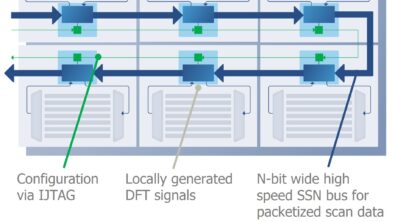How Infineon reduces LBIST test time to meet functional safety requirements
The ICs designed for use in advanced driver assistance systems or autonomous vehicles must meet stringent functional safety standards that include high-quality manufacturing test and in-system test.
Scan-based logic built-in-self-test (LBIST) is an important measure for compliant device. It is widely used for in-system test to detect faults that could violate safety goals. However, the pseudo-random nature of LBIST poses a challenge to automotive microcontroller (MCU) designers: the diagnostic test time interval (DTTI) required to reach a given coverage goal often can’t meet runtime requirements demanded by customers.
Infineon needed to establish a logic BIST for their automotive MCUs that could meet 90% test coverage faster than was possible with traditional logic BIST capabilities. They started using test points to improve testability; both observe test points and control test points. To improve the results of test points even further, they adopted a new observation test point technology called “observation scan.”
Infineon’s experience with observation scan technology was the topic of a presentation at the 2019 International Test Conference by Daniel Tille, the senior manager of DFX at Infineon. That presentation was recorded and is available here.
Tille covers the trends in the automotive industry that are driving ICs to comply with very strict automotive safety standards, which includes high-quality production test and also in-system test for fault detection during the life of the vehicle. Those tests must reach a certain level of coverage and be very quick. The pseudo-random nature of LBIST is not the only challenge to test time; another impediment to test time is that fault detection happens only during the capture phase of the LBIST cycle.
Each LBIST cycle has two phases—shift and capture. There are as many shift cycles as the length of the longest scan chain. The capture phase uses the values written into the scan chain to drive the combinational logic and capture potential faults. That means all the time spent on the shift phase is time you are not detecting faults. Infineon calls this “wasted runtime.”
The new LBIST feature they adopted is called LBIST-OST (Logic BIST with Observation Scan Technology). Tille says it reduces the DTTI by increasing the fault detection period. It does this by capturing fault effects during each shift cycle. Faults can be captured during the shift cycle because the new scan cell functionality that essentially connect the observe points in separate chains. Tille shows in his presentation how that works, along with the benefits and current limitations of the observation scan technology. He finishes by showing a case study that demonstrates the “tremendous” improvement in both the DTTI and the number of LBIST cycles needed to reach 90% test coverage.



